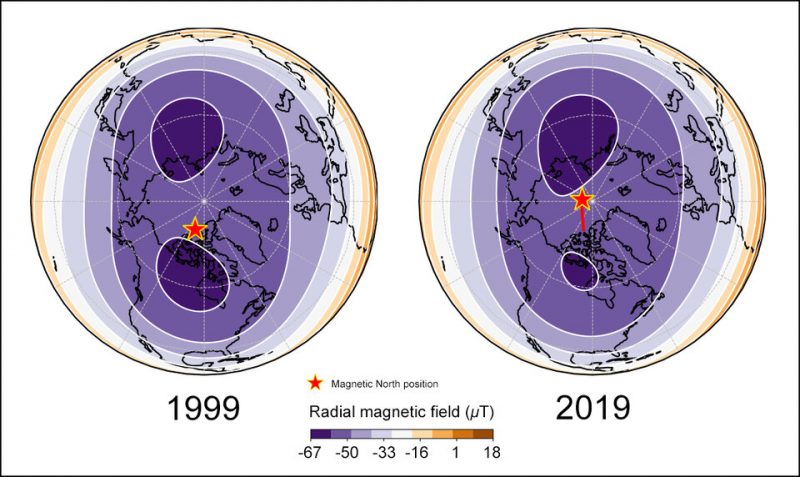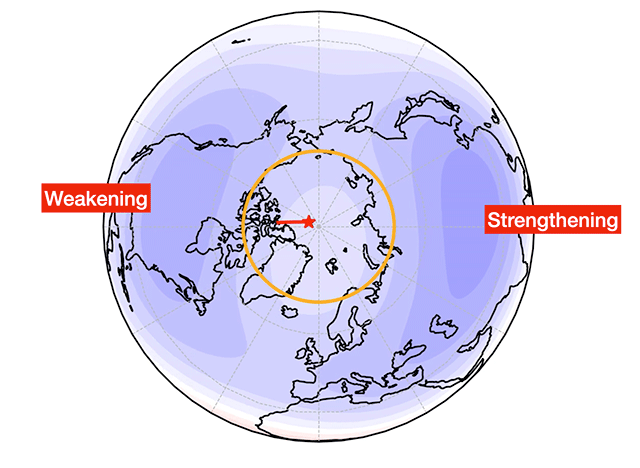You probably know that a compass doesn’t point to true north. Earth’s geographic north pole – and magnetic north pole – were first recognized as two different places in 1831. Until the early 1990s, the magnetic North Pole was known to lie some 1,000 miles south of true north, in Canada. Yet, as scientists realized, the location of magnetic north was not fixed. Magnetic north was drifting at a rate of up to about 9 miles (15 km) a year. Since the 1990s, however, the drift of Earth’s magnetic north pole has turned into “more of a sprint,” scientists say. Its present speed is about 30 to nearly 40 miles a year (50-60 km a year) toward Siberia. And now – using satellite measurements – scientists in Europe have helped confirm a theory as to why Earth’s magnetic north pole is drifting so rapidly.
The European Space Agency (ESA) released this interesting article on May 14, 2020. It describes a new study in the peer-reviewed journal Nature Geoscience that describes the theory of “tussling magnetic blobs deep below Earth’s surface” at the root of the phenomenon of rapid magnetic pole drift since the 1990s. ESA said:
In late October 2017, [the magnetic north pole] crossed the International Date Line, passing within 390 km [242 miles] of the geographic pole, and is now heading south …


In our modern world, it’s not just compasses that are affected by the drift of Earth’s magnetic north pole. ESA explained:
One of the practical consequences of this is that the World Magnetic Model has to be updated periodically with the pole’s current location. The model is vital for many navigation systems used by ships, Google maps and smartphones, for example.
That’s why the subject of magnetic north is such a vital one to our world, and why ESA’s Living Planet Symposium last year featured a talk from scientists at the University of Leeds in the U.K. about their findings on magnetic north, using SWARM satellite data. The Swarm satellites carry sophisticated magnetometers. Their goal, in part, is to provide a survey of Earth’s magnetic field. ESA said:
The data showed that the position of the north magnetic pole is determined largely by a balance, or tug-of-war, between two large lobes of negative flux at the boundary between Earth’s core and mantle under Canada.
Phil Livermore, from the University of Leeds, said:
By analyzing magnetic field maps and how they change over time, we can now pinpoint that a change in the circulation pattern of flow underneath Canada has caused a patch of magnetic field at the edge of the core, deep within the Earth, to be stretched out. This has weakened the Canadian patch and resulted in the pole shifting towards Siberia.
The north magnetic pole is moving fast and in an unexpected way, baffling scientists who are involved in tracking its motions. ?
Dr Phil Livermore from @SEELeeds discusses the movement in @nature.https://t.co/QULuA31xt8 pic.twitter.com/oJwL9BLecV
— University of Leeds (@UniversityLeeds) January 11, 2019
The big question, these scientists say, is whether the pole will ever return to Canada or continue heading south. Livermore explained:
Models of the magnetic field inside the core suggest that, at least for the next few decades, the pole will continue to drift towards Siberia.
However, given that the pole’s position is governed by this delicate balance between the Canadian and Siberian patch, it would take only a small adjustment of the field within the core to send the pole back to Canada.
Bottom line: Scientists studying the drift of Earth’s magnetic north pole have pinpointed a change in the circulation pattern of magnetic blobs deep below Earth’s surface. They’ve learned a change in the flow underneath Canada has caused a patch of magnetic field at the edge of Earth’s core, deep within the Earth, to be stretched out. This has weakened the Canadian patch and resulted in the pole shifting towards Siberia.
Source: Recent north magnetic pole acceleration towards Siberia caused by flux lobe elongation
Read more from the BBC: Scientists explain magnetic pole’s wanderings











